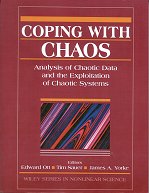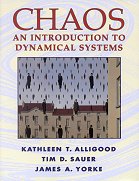Mathematicians have been aware of chaotic dynamics since Poincaré’s work at the turn of the century. But, as the turn of yet another century approaches, physical scientists and engineers have begun to use their understanding of chaos theory to analyze chaotic experimental time series data. Some researchers have even used the presence of chaos to achieve practical goals. To do this, they have had to work with dynamical processes for which the equations were either not known or were too complex to be useful. In other words, they have been coping with chaos.
Coping With Chaos is the first book to bring together recent advances in the interpretive and practical applications of chaos, which hold great promise for broad applicability throughout the physical sciences and engineering. Together with an introduction to chaos theory, this book provides detailed reports on methods of analyzing experimental time series data from chaotic systems and studies in which the unique attributes of chaos are put to practical use. Topics discussed in this book include:
• Theory of chaotic dynamics
• Embedding techniques for the analysis of experimental data
• Calculation of dimension and Lyapunov exponents
• Determination of periodic orbits and symbolic dynamics
• Prediction of chaotic time series
• Noise filtering of chaotic data
• Control of chaotic systems
• The use of Chaotic signals for communication
• And more
Contents
- • George Sugihara, Robert M. May. Nonlinear forecasting as a way of distinguishing chaos from measurement error in time series. Nature, 344, 734-741. 1990
- • Norman H. Packard, James P. Crutchfield, J. Doyne Farmer, Robert S. Shaw. Geometry from a time series. Phys. Rev. Lett. 45:712. 1980
- • D. S. Broomhead, Gregory P. King. Extracting qualitative dynamics from experimental data. Physica D 20:217-236. 1986
- • Matthew B. Kennel, Reggie Brown, Henry D. I. Abarbanel. Determining embedding dimension for phase-space reconstruction using a geometrical construction. Phys. Rev. A 45:3403-3411. 1992
- • Daniel T. Kaplan, Leon Glass. Direct test for determinism in a time series. Phys. Rev. Lett. 68:427-430. 1992
- • A. M. Albano, J. Muench, C. Schwartz, Alistair I. Mees, P. E. Rapp. Singular-value decomposition and the Grassberger-Procaccia algorithm. Phys. Rev. A 38:3017. 1988
- • Jean-Pierre Eckmann, David Ruelle. Fundamental limitations for estimating dimensions and Lyapunov exponents in dynamical systems. Physica D 56:185. 1992
- • Mingzhou Ding, Celso Grebogi, Edward Ott, Tim D. Sauer, James A. Yorke. Plateau onset for correlation dimension: When does it occur?. Phys. Rev. Lett. 70:3872. 1993
- • James Theiler, Stephen G. Eubank, Andre Longtin, Bryan Galdrikian, J. Doyne Farmer. Testing for nonlinearity in time series: The method of surrogate data. Physica D 58:77. 1992
- • A. Brandstater, Harry L. Swinney. Strange attractors in weakly turbulent Couette-Taylor flow. Phys. Rev. A 35:2207. 1987
- • John Guckenheimer, George Buzyna. Dimension measurements for geostrophic turbulence. Phys. Rev. Lett. 51:1438. 1983
- • Jean-Pierre Eckmann, S. Oliffson Kamphorst, David Ruelle, S. Ciliberto. Liapunov exponents from time series. Phys. Rev. A 34:4971. 1986
- • Paul Bryant, Reggie Brown, Henry D. I. Abarbanel. Lyapunov exponents from observed time series. Phys. Rev. Lett. 65:1523. 1990
- • Ulrich Parlitz. Identification of true and spurious Lyapunov exponents from time series. Int. J. Bif. Chaos 2:155. 1992
- • Daniel P. Lathrop, Eric J. Kostelich. Characterization of an experimental strange attractor by periodic orbits. Phys. Rev. A 40:4028. 1989
- • L. Flepp, R. Holzner, E. Brun, M. Finardi, Remo Badii. Model identification by periodic-orbit analysis for NMR-laser chaos. Phys. Rev. Lett. 67:2244. 1991
- • John C. Sommerer, William L. Ditto, Celso Grebogi, Edward Ott, Mark L. Spano. Experimental confirmation of the theory for critical exponents of crises. Phys. Lett. A 153:105. 1991
- • F. Papoff, A. Fioretti, E. Arimondo, G.B. Mindlin, H. Solari, Robert Gilmore. Structure of chaos in the laser with saturable absorber. Phys. Rev. Lett. 68:1128. 1992
- • J. Doyne Farmer, John J. Sidorowich. Predicting chaotic time series. Phys. Rev. Lett. 59:845. 1987
- • Martin Casdagli. Nonlinear prediction of chaotic time series. Physica D 35:335. 1989
- • Tim D. Sauer. Time series prediction using delay coordinate embedding. 1993
- • Eric J. Kostelich, James A. Yorke. Noise reduction in dynamical systems. Phys. Rev. A 38:1649. 1988
- • Peter Grassberger, Rainer Hegger, Holger Kantz, Carsten Schaffrath, Thomas Schreiber. On noise reduction methods for chaotic data. Chaos 3:127. 1993
- • Stephen M. Hammel. A noise reduction method for chaotic systems. Phys. Lett. A 148:421. 1990
- • Edward Ott, Celso Grebogi, James A. Yorke. Controlling chaos. Phys. Rev. Lett. 64:1196. 1990
- • Ute Dressler, Gregor Nitsche. Controlling chaos using time delay coordinates. Phys. Rev. Lett. 68:1. 1992
- • Filipe J. Romeiras, Celso Grebogi, Edward Ott, W. P. Dayawansa. Controlling chaotic dynamical systems. Physica D 58:165. 1992
- • Hua Wang, Eyad H. Abed. Bifurcation control of chaotic dynamical systems. Proc. IFAC Nonlinear Control Systems Design Symp.. 1992
- • William L. Ditto, S. N. Rauseo, Mark L. Spano. Experimental control of chaos. Phys. Rev. Lett. 65:3211. 1990
- • Jonathan Singer, Y.-Z. Wang, Haim H. Bau. Controlling a chaotic system. Phys. Rev. Lett. 66:1123. 1991
- • Alan Garfinkel, Mark L. Spano, William L. Ditto, James N. Weiss. Controlling cardiac chaos. Science 257:1230. 1992
- • E. R. Hunt. Stabilizing high-period orbits in a chaotic system: The diode resonator. Phys. Rev. Lett. 67:1953. 1991
- • Zelda Gills, Christina Iwata, Rajarshi Roy, Ira B. Schwartz, Ioana Triandaf. Tracking unstable steady states: Extending the stability regime of a multimode laser system. Phys. Rev. Lett. 69:3169. 1992
- • Valery Petrov, Vilmos Gaspar, Jonathan Masere, Kenneth Showalter. Controlling chaos in the Belousov-Zhabotinsky reaction. Nature 361:240. 1993
- • Troy Shinbrot, William L. Ditto, Celso Grebogi, Edward Ott, Mark L. Spano, James A. Yorke. Using the sensitive dependence of chaos (the "butterfly effect") to direct trajectories in an experimental chaotic system. Phys. Rev. Lett. 68:2863. 1992
- • Alfred Hubler, E. Luscher. Resonant stimulation and control of nonlinear oscillators. Naturwissenschaften 76: 67. 1989
- • E. Atlee Jackson. The entrainment and migration controls of multiple-attractor systems. Phys. Lett. A 151:478. 1990
- • Louis M. Pecora, Thomas L. Carroll. Synchronization in chaotic systems. Phys. Rev. Lett. 64:821. 1990
- • Kevin M. Cuomo, Alan V. Oppenheim. Circuit implementation of synchronized chaos with applications to communication. Phys. Rev. Lett. 71:65. 1993
- • Scott Hayes, Celso Grebogi, Edward Ott. Communicating with chaos. Phys. Rev. Lett. 70:3031. 1993
- • Paul So, Edward Ott, W. P. Dayawansa. Observing chaos: Deducing and tracking the state of a chaotic system from limited observation. Phys. Lett. A 176:421. 1993

